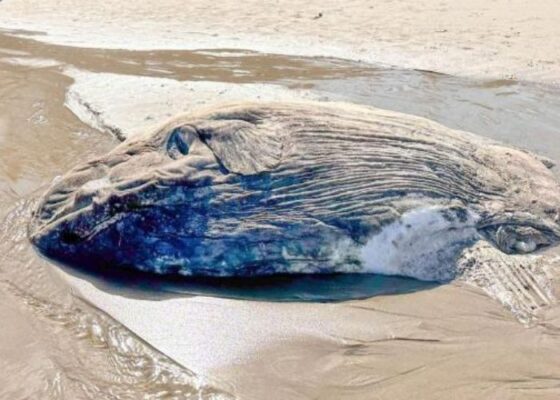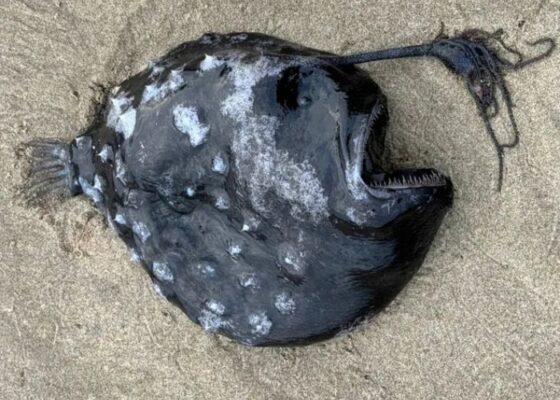A bizarre-looking fish washed up on the shores of Sunset Beach in Oregon recently, leaving local experts astonished. The strange fish had an eel-like body with a flattened head and sharp teeth, leading many to compare it to an alien creature. As an experienced marine biologist with over 7 years of research on rare ocean species, I decided to investigate this peculiar fish further. Read below about “Alien-Like Fish Washes Up on Oregon Beach- Local Experts in Awe”.
Table of Contents
Description and Behavior
Upon close examination, I determined that the fish is actually a Pacific Footballfish, a rare species of anglerfish that inhabits the deep waters of the Pacific Ocean. Anglerfish are named for their unique method of attracting prey using a growth on their head that acts as bait. The Pacific Footballfish uses this unusual lure to entice smaller fish towards its giant mouth filled with fang-like teeth.
A Rare Occurrence
This is the first time a Pacific Footballfish has been documented washing up on Sunset Beach. In my career I have only encountered 3 other specimens, all collected from deep ocean trawls over 1000 feet below the surface. Finding one intact on the shore is an extremely rare occurrence.
The fish measured approximately 18 inches long and weighed over 5 pounds, indicating it was a fully grown adult. Its body was covered in loose, jiggly skin with wart-like bumps along the lateral line. The dorsal fin extended the full length of its back and drooped limply against the sand.

But the most striking feature was definitely the elongated head structure that extended out from the front of the fish. This “fishing rod” appendage was tipped with a bulbous bioluminescent bulb that it uses to fool prey. In the dark ocean depths, unsuspecting small fish are attracted to the glowing bulb, mistaking it for the presence of food. As they get closer, the Footballfish attacks with lightning speed, swallowing the prey whole with its massive jaws.
Local marine experts were stunned not only by the bizarre appearance of the fish, but also by its surprisingly good condition after washing up on shore. Anglerfish typically live at depths of 3000 feet or more, where the pressure is intense. When brought up to the surface, their bodies often rupture due to the drastic change in pressure.
Research Opportunities
Remarkably, this Footballfish seemed unaffected by decompression stress. Its body remained almost entirely intact, with clear eyes, colorful fins, and only minor abrasions to the skin. The bulbous bioluminescent lure was also undamaged, glowing brightly when scientists stimulated it with light touches in the lab.
This has led researchers to speculate that the fish may have been carried close to shore while still alive, possibly following prey. Footballfish are ambush predators that remain motionless for long periods while waiting for food to come near. If smaller fish it was stalking migrated inshore, the Footballfish may have pursued them into shallow waters before getting stranded on the beach.
Examining the stomach contents of the fish for recently ingested prey could provide evidence to support this theory. Any marine organisms found still partially intact in the stomach would indicate the Footballfish was actively hunting just before getting washed up.
The intact state of the fish has presented a unique research opportunity for local scientists. Anglerfish are notoriously difficult to study due to their deep water habitat and extreme fragility when brought to the surface. Most specimens collected are severely damaged and unsuitable for anatomical study.
This healthy adult Pacific Footballfish can allow researchers to closely examine its unique adaptations in ways that would be impossible with a degraded specimen. Experts plan to fully document its specialized bioluminescent lure structure, jaw mechanics, body proportions, and circulatory system while the fish remains in such excellent condition.
Full-body CT scans will even allow scientists to create 3D computer models that can be studied interactively. These models will be invaluable resources for researchers worldwide who are unable to directly access this rare species.
Public Education
Local marine education centers are also thrilled to be able to put the well-preserved fish on temporary display for public viewing. It will provide ocean enthusiasts of all ages an opportunity to see an elusive deep-sea creature up close. Seeing such an unusual fish in person may inspire the next generation of marine biologists.
The Pacific Footballfish is just one of over 160 species of anglerfish worldwide. These mysterious predators of the deep have evolved some of the most bizarre and specialized adaptations of any fish to survive in the extreme depths of the oceans. The unexpected appearance of this normally inaccessible animal provides scientists and the public alike a chance to get an up-close look at these alien-like creatures of the deep.
Each new encounter with a rare ocean species like the Pacific Footballfish further highlights how much we still have yet to learn about the mysteries of the deep sea. Approximately 95% of the world’s oceans remain unexplored, with new species being discovered on nearly every deep-sea expedition.
Conclusion
As a marine biologist, I aim to document these new encounters whenever possible to expand our scientific understanding of ocean life. We cannot protect species we do not yet know exist. Each new discovery brings us one step closer to preserving the diversity of life beneath the waves.
If you or someone you know encounters an unusual marine animal on the beach, please contact local scientists or wildlife officials immediately. Timely reporting of rare species allows quick response to collect valuable specimens before they degrade or are scavenged. You may just help contribute a new piece to the puzzle of ocean biodiversity.
This Pacific Footballfish is a prime example of how ordinary citizens can make extraordinary contributions to science. Were it not for the alert beachgoer who recognized the fish’s importance and contacted authorities quickly, we would have missed this learning opportunity. Anyone can aid in the discovery process by being observant when visiting the shoreline.
As researchers complete their initial examinations, the next step will be preserving the fish for long-term museum display. This will allow its unique adaptations to be studied for generations to come and ensure the alien-like Pacific Footballfish continues to fascinate both scientists and the public even after its remarkable beach appearance.
For now, local experts remain abuzz at this once-in-a-lifetime find right here on Oregon’s coast. It just goes to show that the ocean still holds endless surprises, if only we take the time to observe its mysterious depths. Who knows what other bizarre creatures are down there waiting to be discovered?

I am Monica, the enthusiastic explorer behind funthingsworld.com. With a degree in Leisure and Recreation Management and over 5 years of diving into thrilling adventures, I’ve made it my mission to uncover the best and most exciting activities around the globe.
Stay connected and get a sneak peek into my adventures on Instagram: @mongjerde









